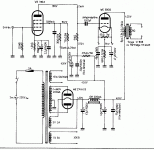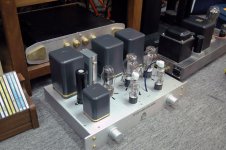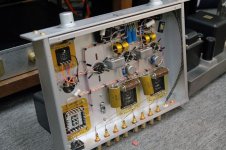Hi folks
Recently my friend had built a SE 300B amp which is only 2 stages. He used WE310 to drive China made 300B.
After the listening, we discovered that the machine's sound stage is very dim and the high range seem lower than expected.
We arrange a simple test for the gain level of certain frequency and found the following:
1) concentrate the testing on WE310 output, i.e. the milli volgage meter connected to the output cap. of WE310
2) WE310 fed by 310V B+ approx. and the plate voltage is 220V approx., the cathode is measured 4.6V accross the cathode resistor of 1.5K
3) WE310 is connected as penthode
4) the frequency is starting to roll off at 2Khz !!! when 12Khz applied to WE310, the gain down to 1/2 only as compared to 1 Khz
We wondered why frequency response of WE310 will start to roll off at 2 Khz !!
We tried it's identical - 6C6, same result !!!
Later, we tried to connect 6C6 as triode. The result is - only start to roll off at 23 Khz !!!! But the gain is also rolled off !!!!!
So, anybody has this experience in using WE310 connected as penthode ?
Any comment to play with this expensive tube ?🙂
Thanks for anyone could teach me how to solve this big problem 🙂
Recently my friend had built a SE 300B amp which is only 2 stages. He used WE310 to drive China made 300B.
After the listening, we discovered that the machine's sound stage is very dim and the high range seem lower than expected.
We arrange a simple test for the gain level of certain frequency and found the following:
1) concentrate the testing on WE310 output, i.e. the milli volgage meter connected to the output cap. of WE310
2) WE310 fed by 310V B+ approx. and the plate voltage is 220V approx., the cathode is measured 4.6V accross the cathode resistor of 1.5K
3) WE310 is connected as penthode
4) the frequency is starting to roll off at 2Khz !!! when 12Khz applied to WE310, the gain down to 1/2 only as compared to 1 Khz
We wondered why frequency response of WE310 will start to roll off at 2 Khz !!
We tried it's identical - 6C6, same result !!!
Later, we tried to connect 6C6 as triode. The result is - only start to roll off at 23 Khz !!!! But the gain is also rolled off !!!!!
So, anybody has this experience in using WE310 connected as penthode ?
Any comment to play with this expensive tube ?🙂
Thanks for anyone could teach me how to solve this big problem 🙂
Do you know how much capacitance your AC voltmeter has? It may be enough to affect your measurements. A pentode has a high output impedance and triode is lower, so it will have less high-frequency roll-off for the same capacitance.
Most standard multimeters arent capable of higher than 50 Hz measurements. Some work up to 1-2 kHz, but you'll need a true RMS multimeter, or better an oscilloscope to measure the frequency range correctly.
Thanks for all of you.
To Palustris : the screen was bypassed previously but it is connected to the cathode now. The result is only slightly better than directly bypassed to ground.
To Tom Bavis & pauldune : I'll check it and tell you.
Thanks again.
To Palustris : the screen was bypassed previously but it is connected to the cathode now. The result is only slightly better than directly bypassed to ground.
To Tom Bavis & pauldune : I'll check it and tell you.
Thanks again.
Hi folks
The mV meter is no problem and is catered for the measurement of precise reading for audio.
The measurement instruments are all for audio !!
So, we wondered that WE310 is a really legendary tube ?
Should we to clarify and to prove some legendary tube using testing machine ?
Even we directly plug in a 6C6 (also WE !!!), except we change the filament voltage, the result still better than WE310 !!!
The mV meter is no problem and is catered for the measurement of precise reading for audio.
The measurement instruments are all for audio !!
So, we wondered that WE310 is a really legendary tube ?
Should we to clarify and to prove some legendary tube using testing machine ?
Even we directly plug in a 6C6 (also WE !!!), except we change the filament voltage, the result still better than WE310 !!!
The only thing I can say after some thinking, is that or your circuit is faulty, the tube is broken, or you don't measure correctly.
I don't think there were ever tubes created that had a frequency range lower then 2 kHz.
What happens when you measure without the 300b? If the frequency range is a lot better, than maybe its the miller capacity of the 300b. Can't be shure without a schematic...
I don't think there were ever tubes created that had a frequency range lower then 2 kHz.
What happens when you measure without the 300b? If the frequency range is a lot better, than maybe its the miller capacity of the 300b. Can't be shure without a schematic...
Who makes the meter you are using to take the measurements? Bench meters can read well up to 100Khz but like pauldune says, handhelds aren't good above a few Khz.
Do you have access to an oscilloscope? That will make finding the problem much easier.
Do you have access to an oscilloscope? That will make finding the problem much easier.
300B has a grid-to-plate capacitance of 15 pF and a amplification factor of 4, so there will be 60 pF of Miller capacitance to drive. The output impedance of a pentode stage is pretty much the same as its plate load - maybe 100K? So the -3dB point at the grid will be around 25 KHz. Your meter might have 30 pF input capacitance, and 5 feet of coax cable, another 150 pF. So it would roll off by 3 dB about 8 KHz...
As a triode, a 310 or 6C6 might have a 10K output impedance (plate load resistor in parallel with plate resistance) and so would have a -3dB point about 10 times the pentode's.
As a triode, a 310 or 6C6 might have a 10K output impedance (plate load resistor in parallel with plate resistance) and so would have a -3dB point about 10 times the pentode's.
Last edited:
Hi folks
...The mV meter is no problem and....
Is this a typo? Or is it really a mV meter? Because you should measure 10s of volts.
If you want some real help, please draw a schematic of the amp, and how you are trying to measure... Then we dont have to guess...
greetz, Paul
Hi Palustris
Thanks for your help.
The circuit attached.
We are using the following instruments:
Signal generator :LEADER LAG-120B
Voltage meter : TRONEER TVT 32C
Again, we measure the frequency response from the output of the WE310, and we tried with and without the plug in of 300B, the result is the same.
All of the irons of the tube amp is made of Tamura, so we would not doubt about any indirect effect on WE310.
We had tried 6C6 and result is just slightly good.
After the trial of triode connection, everything is changed and roll off until 23Khz. But the output gain was dramatically roll off too, about only 1/5 of penthode connection.
So the suspect of other components fault can be eliminated.
Some penthode connection is by-passing the screen cap. to the cathode and we tried. The result is only slightly better than by-passed to ground, still starting to roll off at earlier response, properly at 4Khz and I can't remember.
Very frustrated!!! Hope folks can help us.
Thanks for your help.
The circuit attached.
We are using the following instruments:
Signal generator :LEADER LAG-120B
Voltage meter : TRONEER TVT 32C
Again, we measure the frequency response from the output of the WE310, and we tried with and without the plug in of 300B, the result is the same.
All of the irons of the tube amp is made of Tamura, so we would not doubt about any indirect effect on WE310.
We had tried 6C6 and result is just slightly good.
After the trial of triode connection, everything is changed and roll off until 23Khz. But the output gain was dramatically roll off too, about only 1/5 of penthode connection.
So the suspect of other components fault can be eliminated.
Some penthode connection is by-passing the screen cap. to the cathode and we tried. The result is only slightly better than by-passed to ground, still starting to roll off at earlier response, properly at 4Khz and I can't remember.
Very frustrated!!! Hope folks can help us.
Attachments
I have a question regarding the 274b rectifier. Everything I have read strongly suggests no more than 4uf for the first cap after the tube. Do I missunderstand?
Could there be a power suppy problem with inability to provide full current under load?
Not speaking from much knowledge here.
Could there be a power suppy problem with inability to provide full current under load?
Not speaking from much knowledge here.
How are you connecting the meter? What is capacitance of meter INCLUDING test leads? I would measure with a 'scope with 10X probe (< 10 pF).
You need to give us the actual specifications for your meter, absolutely nothing useful comes up using google.
In general using a meter is not a great way to do a frequency response measurement unless you absolutely know the meter is flat to well beyond 20kHz - which it might or might not be.. I have several that are, but still generally use a scope.
Try measuring the generator output through a 100K series resistance with that meter and let us know what sort of response you measure - if good the meter is basically exonerated.
In general using a meter is not a great way to do a frequency response measurement unless you absolutely know the meter is flat to well beyond 20kHz - which it might or might not be.. I have several that are, but still generally use a scope.
Try measuring the generator output through a 100K series resistance with that meter and let us know what sort of response you measure - if good the meter is basically exonerated.
I wouldn't think so, as I understand it this limit was there to prevent stress to the rectifier due to high inrush current. So it may shorten rectifier life, but it shouldn't affect it's ability to deliver full current....no more than 4uf for the first cap...Could there be a power suppy problem with inability to provide full current under load?
Hi folks
Every consideration we have made including testing instruments up to the testing cable. But the result still the same.
So, if anyone's tube machine has this config. or the similar, would you please try to measure the output of WE310 or 6C6 merely and share the experience.
Thanks guys.
Ps. have a look of the machine
Every consideration we have made including testing instruments up to the testing cable. But the result still the same.
So, if anyone's tube machine has this config. or the similar, would you please try to measure the output of WE310 or 6C6 merely and share the experience.
Thanks guys.
Ps. have a look of the machine
Attachments
what's output impedance of signal gene ?
lately one chap had problems with his tests , just to realize that he didn't plug 600R bridge across output of gene ;
I'm not familiar with your Leader , so I'm asking just in case ....
lately one chap had problems with his tests , just to realize that he didn't plug 600R bridge across output of gene ;
I'm not familiar with your Leader , so I'm asking just in case ....
Schedule looks good... don't think there is anything wrong with that. If it's the input capacitance of the meter, you should get a higher roll of when you measure at the speaker connections. If it rolls of higher, don't use the meter anymore for freq range measurement.
How does the amplifier sound? If you really have a -3db of 2Khz, you wouldnt hear high frequencys at all.
How does the amplifier sound? If you really have a -3db of 2Khz, you wouldnt hear high frequencys at all.
Yeah it seems to me that this circuit should easily reach 20kHz in the driver stage, something very odd is going on here. Lots of people have built variations of this circuit and none report bandwidths of 2kHz..
I would start by rechecking that every component in the driver circuit is the actual value you think it is.
Look for inadvertent shunt capacitance between the plate circuit of your pentode and ground and/or anywhere else you can think of.
I also noticed that there is a serious error in the schematic as drawn - where is the grid resistor from the 300B grid to ground - what is its value? I would recommend no more than 220K even in self bias.
<IMPORTANT>Did you do the experiment with the meter that I suggested in my last post - you want to make sure that the meter works properly when driven by a 100K source impedance which is very close to the driver source impedance in your amplifier. You may find that it does not, particularly if the input capacitance is 100pF or more. (100pf with a 100K source is -3dB @ ~16kHz) </IMPORTANT>
I would start by rechecking that every component in the driver circuit is the actual value you think it is.
Look for inadvertent shunt capacitance between the plate circuit of your pentode and ground and/or anywhere else you can think of.
I also noticed that there is a serious error in the schematic as drawn - where is the grid resistor from the 300B grid to ground - what is its value? I would recommend no more than 220K even in self bias.
<IMPORTANT>Did you do the experiment with the meter that I suggested in my last post - you want to make sure that the meter works properly when driven by a 100K source impedance which is very close to the driver source impedance in your amplifier. You may find that it does not, particularly if the input capacitance is 100pF or more. (100pf with a 100K source is -3dB @ ~16kHz) </IMPORTANT>
Last edited:
Hi folks
Thanks for everybody's helping hands !!!
To kevinkr : the test for signal generator haven't yet tried ! I will do it on monday and tell you the result.
For the grid resistor of 300B, we use 250K. The coming trial will use the 200K.
To pauldune: well, the listening test was vocals almostly and lack of variety of different music instruments !!! So, this couple days we will try to play some classic and rock.
Thanks all again, and we'll keep on digging .....
Thanks for everybody's helping hands !!!
To kevinkr : the test for signal generator haven't yet tried ! I will do it on monday and tell you the result.
For the grid resistor of 300B, we use 250K. The coming trial will use the 200K.
To pauldune: well, the listening test was vocals almostly and lack of variety of different music instruments !!! So, this couple days we will try to play some classic and rock.
Thanks all again, and we'll keep on digging .....
- Status
- Not open for further replies.
- Home
- Amplifiers
- Tubes / Valves
- Question on WE310


